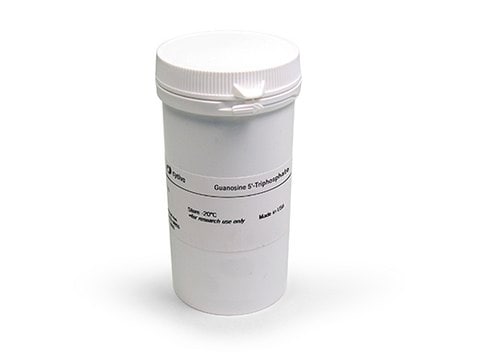Key Documents
10999644001
Roche
SP6/T7 Transcription Kit
sufficient for 2 x 20 assays (stadard transcription), kit of 1 (12 components), suitable for DNA sequencing, suitable for hybridization
Synonim(y):
rna labeling, radioactive, transcription kit sp6/t7
About This Item
Polecane produkty
zastosowanie
sufficient for 2 x 20 assays (stadard transcription)
Poziom jakości
opakowanie
kit of 1 (12 components)
producent / nazwa handlowa
Roche
metody
DNA sequencing: suitable
hybridization: suitable
temp. przechowywania
−20°C
Opis ogólny
DNA inserted into the transcription vectors pSPT18 or pSPT19.The template DNA must be linearized with a suitable restriction enzyme before the transcription reaction to obtain transcripts of a defined length. Using intact plasmid DNA as template for transcription will result in heterogeneous transcripts of multiple plasmid lengths.
Specyficzność
Zastosowanie
For in vitro transcription of DNA sequences cloned downstream of the SP6 or T7 promoter. Homogeneously labeled RNA can be synthesized with high efficiency (60 - 70% incorporation) using either radioactively (e.g.,32P, 3H, 35S) labeled or nonradioactively (e.g., digoxigenin or biotin) labeled ribonucleotides. Labeled transcripts lend themselves to all DNA and RNA hybridization techniques and are also used for genomic sequencing and S1 nuclease studies. Large amounts of highly pure RNA can be synthesized using the SP6/T7 system. These transcripts are used for studies on RNA-processing systems. Synthesized RNA can be translated in vitro, or in vivo after injection into oocytes. The transcription of defined mRNA can be inhibited by the introduction of "antisense"-RNA. The efficiency of in vivo translation of synthesized mRNA can be increased significantly by the introduction of a cap structure.
Opakowanie
Zasada
Uwaga dotycząca przygotowania
ATP, GTP, UTP mixture
Prepare the ATP, GTP, UTP mixture by making a 1:1:1 mixture of solution 4, solution 6, and solution 7.
Transcription Assay with digoxigenin-11-UTP
ATP, GTP, CTP mixture 1
Mix 1:1:1 of ATP (vial 4), CTP (vial 5), and GTP (vial 6).
UTP/DIG-11-UTP mixture
Mix 1:1 digoxigenin-11-UTP (6 mM) with UTP (vial 7) and add as one part to mixture 1.
"Cold" Transcription
ATP, GTP, CTP, UTP mixture
Prepare this mix by combining solutions in vials 4, 5, 6 and 7 at a ratio of 1111.
Inne uwagi
Tylko elementy zestawu
- pSPT18 DNA 0.25 mg/ml
- pSPT19 DNA 0.25 mg/ml
- Control DNA, (pSPT18- and pSPT19-neo-DNA, cleaved with Eco RI) 0.5 mg/ml
- ATP, in Tris buffer 10 mM
- CTP, in Tris buffer 10 mM
- GTP, in Tris buffer 10 mM
- UTP, in Tris buffer 10 mM
- Transcription Buffer 10x concentrated
- DNase I, RNase free, in buffer with 50% glycerol
- RNase Inhibitor, in buffer with 50% glycerol
- SP6 RNA Polymerase, in buffer with 50% glycerol
- T7 RNA Polymerase, in buffer with 50% glycerol
Hasło ostrzegawcze
Warning
Zwroty wskazujące rodzaj zagrożenia
Zwroty wskazujące środki ostrożności
Klasyfikacja zagrożeń
Eye Irrit. 2 - Skin Sens. 1
Kod klasy składowania
12 - Non Combustible Liquids
Klasa zagrożenia wodnego (WGK)
WGK 2
Temperatura zapłonu (°F)
does not flash
Temperatura zapłonu (°C)
does not flash
Certyfikaty analizy (CoA)
Poszukaj Certyfikaty analizy (CoA), wpisując numer partii/serii produktów. Numery serii i partii można znaleźć na etykiecie produktu po słowach „seria” lub „partia”.
Masz już ten produkt?
Dokumenty związane z niedawno zakupionymi produktami zostały zamieszczone w Bibliotece dokumentów.
Klienci oglądali również te produkty
Nasz zespół naukowców ma doświadczenie we wszystkich obszarach badań, w tym w naukach przyrodniczych, materiałoznawstwie, syntezie chemicznej, chromatografii, analityce i wielu innych dziedzinach.
Skontaktuj się z zespołem ds. pomocy technicznej






